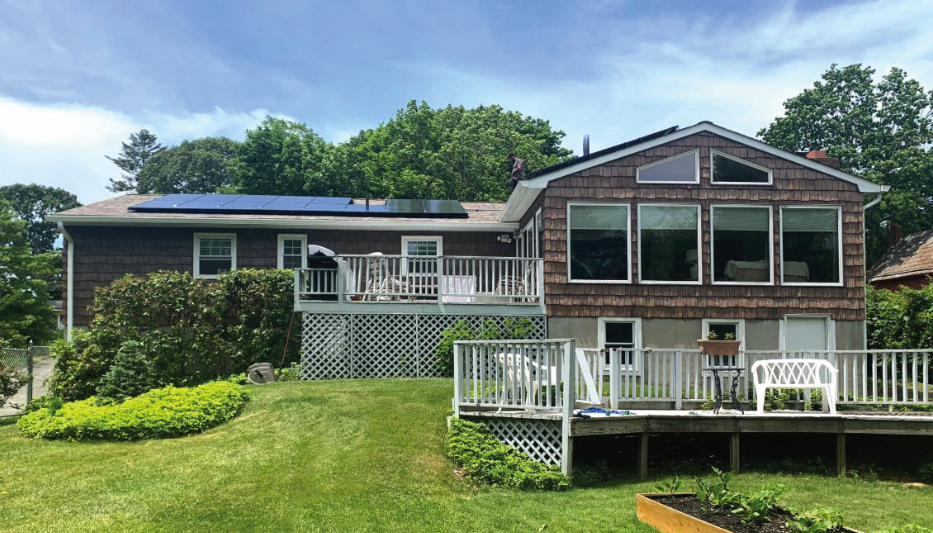All
NORA Opens Industry’s First Net-Zero Home

Field demonstration to prove that residential carbon emissions can be reduced to zero using renewable liquid heating fuel
The National Oilheat Research Alliance (NORA) is setting out to prove that homeowners can reduce a home’s carbon emissions to zero using a renewable low-carbon liquid fuel and solar panels. Indeed, the demonstration has already begun in Port Jefferson, New York, at the home of NORA Director of Research Dr. Thomas Butcher.
NORA has helped lead the transition to low carbon liquid fuels in the home heating sector for decades through testing and promoting the use of the advanced biofuel, biodiesel, in combination with traditional heating oil. NORA’s liquid fuels research laboratory in Plainview, New York is among the country’s leading facilities conducting this type of research.
With public policy in many of the Northeast states calling for drastic reductions in carbon emissions, and with traditional heating oil unable to satisfy those requirements, NORA intends to show that the combination of 100% biodiesel partnered with solar panels can bring the home to zero carbon emissions.
This strategy is an alternative to “all electric” policies that call for replacing all combustion heating and other home appliances with power-grid-run electric furnaces, boilers and appliances. The all-electric plan will place enormous strain on the utilities and the grid while also placing massive financial burdens on homeowners as they are required to replace their current heating systems with heat pumps. NORA’s zero-carbon home can achieve carbon reduction mostly using existing heating systems and commercially available solar panel systems.
Taking the Carbon Out of the Fuel
The first step in decarbonizing a home heating system is transitioning to a low-carbon biofuel. The biofuel widely available to the heating market in the Northeast is biodiesel (ASTM D6751). Relative to petroleum No. 2 fuel, 100% biodiesel (B100) provides a carbon reduction of 75% to 90%, with the higher 90% reduction based on the use of waste feed stocks such as used cooking oil. Replacing petroleum with B100 can provide reductions in carbon of up to 90%.
Work is ongoing within the biodiesel industry on reducing even the small amount of carbon emissions associated with biodiesel production, and the picture is expected to get even better. The residual emissions can be minimized using a high-efficiency boiler of furnace.
The transition to B100 was made at the Butcher home in 2020 with the biodiesel fuel supplied by Hart Home Comfort, of Oakdale, New York. The home’s steel tank is indoors and approximately 15 years old. The tank was filled without cleaning prior to the introduction to B100. There have been no notable service issues since the transition. The heating system includes an Energy Kinetics System 2000 boiler, about 10 years old.
Adding Solar Panels
The second step is the addition of solar panels on the roof of the home, which can produce more or less power than the home needs at any time of the day. The system installed at Butcher’s home does not include a storage battery, but rather “extra” power is exported back to the grid.
The home’s historical annual electric power use, including central air conditioning, is 7,199 kilowatt hours. The annual production capacity of the solar panels installed is a nominal 7,914 kilowatt hours.
In addition to eliminating carbon associated with power used in the home, the surplus power sent back to the grid reduces carbon emissions further and provides an offset to the small amount of carbon emissions associated with the biodiesel use.
Making Financial Sense
The solar panel system at Dr. Butcher’s home was installed by Long Island Power Solutions, of Ronkonkoma, New York. The state and federal government offered financial incentives for installing solar panels, making the installation attractive.
At the time the installation was planned, the residential power rate was approximately $0.23 per kilowatt hour. At this rate, the payback period was calculated at seven years with an effective annual payback of 14.3%. At the time of this writing, it has risen to $0.28 per kilowatt hour, making the payback period drop to 5.74 years, after which the electric cost will effectively be zero.
“With uncertainty about future rates, I feel this was a great step to eliminate electric bills,” noted Dr. Butcher. “These steps to quickly make my home carbon-free have been very easy. I didn’t make any changes to my heating system. The investment I have made in the solar panels will pay back quickly and I feel we are ready for the upcoming decades with a system that keeps us warm, provides plenty of hot water, and will end up being the cheapest approach.”
NORA’s Net Zero Carbon Home will continue to be monitored for financial returns and greenhouse gas reduction values, and upgrades to further the carbon emission reductions will be assessed.
Getting Involved
NORA would like to extend the Zero-Carbon Home project to other U.S. states. If you have an interest in working with NORA, contact info@noraweb.org.
Related Posts
 From Blue Flame to Biofuels
From Blue Flame to Biofuels
Posted on June 25, 2025
 HEAT Show Announces Fenway Park Backyard BBQ
HEAT Show Announces Fenway Park Backyard BBQ
Posted on May 15, 2025
 Delivering New York City’s Clean Energy Solutions
Delivering New York City’s Clean Energy Solutions
Posted on May 14, 2025
 Are You a Leader or a Boss? The Choice is Yours
Are You a Leader or a Boss? The Choice is Yours
Posted on May 14, 2025
Enter your email to receive important news and article updates.
